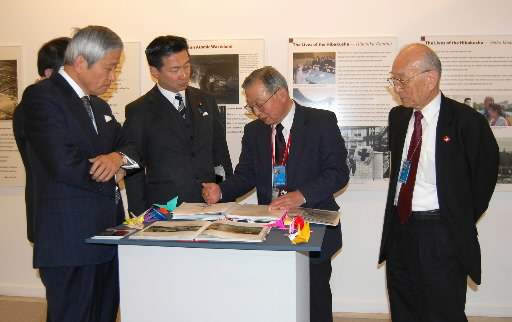Nuclear Weapons Can Be Eliminated: Chapter 11, Part 3
Jun. 9, 2010
Chapter 11: 2010 NPT Review Conference
Part 3: Presence of the A-bombed Nation
by Yumi Kanazaki, Staff Writer
Coordination concerning the Middle East yields results
The Nuclear Non-proliferation Treaty (NPT) Review Conference, which is held every five years, has adopted a final document with an action plan of 64 items in pursuit of nuclear disarmament, non-proliferation, and the peaceful use of nuclear energy. However, there were concerns that the discussions, which took place over a period of four weeks, from May 3-28, at United Nations Headquarters in New York, might break down, as they did at the review conference five years ago, if a wrong move was made. The Chugoku Shimbun reflects on the developments, including actions taken behind the scenes, of this year's NPT Review Conference, which has managed to sustain the international momentum for nuclear disarmament.
Evasive about its reliance on "nuclear umbrella," Japan, in part, leads nuclear disarmament discussion
On May 14, when the Nuclear Non-proliferation Treaty (NPT) Review Conference entered its middle stage, Sueichi Kido, 70, an A-bomb survivor living in the city of Gifu, headed to the conference venue crowded with state delegates and stopped Nobuyasu Abe, Special Assistant to the Minister for Foreign Affairs.
"Please say to them, 'The A-bombed nation of Japan will be the first to leave the nuclear umbrella.'" Mr. Kido said this to Mr. Abe after praising the joint statement on the promotion of disarmament education, led by the Japanese government, that was presented to the conference three days earlier. Mr. Kido's words revealed his dissatisfaction about the current situation in which his nation remains dependent on U.S. nuclear deterrence for its security.
"Disarmament education and nuclear disarmament are equally important." Mr. Abe limited himself to this reply.
"Safe" contents of proposals
The NPT Review Conference this time has adopted a final document mainly comprised of an action plan of 64 items. At a news conference on the evening of May 28, immediately after the closing of the conference, Akio Suda, the permanent representative of Japan to the Geneva-based Conference on Disarmament, said proudly, "Most of our proposals on disarmament have been reflected in the final document."
The proposals, jointly presented by Japan and Australia to the conference, consisted of 16 items. These proposals called for reducing the role of nuclear weapons and ensuring transparency of nuclear weapons capabilities, among other things, based on the final report compiled last year by the International Commission on Nuclear Non-proliferation and Disarmament (ICNND), which has been backed by both governments.
However, Akira Kawasaki, executive committee member of Peace Boat, a Tokyo-based NGO, commented, "The ideas from the ICNND report were further watered down in their proposals. It can't be said that the contents of these proposals are unique to the A-bombed nation. The proposals were not criticized, as the contents are safe."
Forsaking a good opportunity
Tetsuro Fukuyama, State Secretary for Foreign Affairs of Japan, delivered a speech at the conference as a representative of the Japanese government. There are voices expressing regret even within the Ministry of Foreign Affairs of Japan: "If the Japanese prime minister had delivered a speech, the A-bombed nation of Japan could have more strongly publicized its stance of spearheading the campaign for nuclear abolition." The Japanese foreign minister did not attend the conference, either. In the end, the leaders of the A-bombed nation of Japan, who assumed power in a change of government last autumn, chose to forsake a good opportunity to call attention to their "change" and their "political leadership."
At the same time, this does not mean that Japan showed no presence at the conference.
On the evening of May 27, the day before the conference ended, copies of the draft of the final document were distributed, to which some sentences to the effect that "The nuclear-weapon States are called upon to report the above undertakings to the Preparatory Committee at 2014. The 2015 Review Conference will take stock and consider the next steps for the full implementation of Article VI" had been added. It is said that Japan pushed this language into the draft in place of the phrase "to convene an international conference in 2014 to consider ways and means to agree on a roadmap for the complete elimination of nuclear weapons," which had been removed in the negotiating process prior to that point.
U.N. diplomatic sources praised the fact that Japan was able to persuade the five nuclear weapon states to accept this language and this achievement then led to the adoption of the final document.
Still, it cannot be said that Japan is clear in its view, compared to the argument of Switzerland, which stressed the illegality of nuclear weapons, and the arguments of Norway and Austria, both of which denounced the inhumanity of nuclear weapons. Japan did not sympathize with goals having time limits, either, including the elimination of nuclear weapons by 2025, which was advocated by some nations of the Non-Aligned Movement.
The A-bombed nation of Japan, if not other nations, should have rejected nuclear weapons flatly, including the "nuclear umbrella," and insisted on the elimination of these weapons more strongly.
(Originally published on June 5, 2010)
To comment on this article, please click the link below. Comments will be moderated and posted in a timely fashion. Comments may also appear in the Chugoku Shimbun newspaper.








